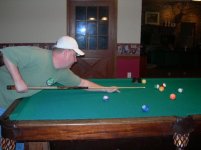i had a very good cue maker make me a southwest copy. He used the same woods that are in my southwest, he used a brass 3/8 11 pin like they use and it looks almost identical but his cue has a much lower tone than the southwest, why is this?
you can have a cue maker build you 2 cues using the same method, and the same woods from the same tree and same, tip, ferrule, joint, rings, and pin.
chances are that the 2 cues will play a bit different and have a bit different tone, as you are dealing with organic materials and most are a bit different.
Ab-so-lutely...
FWIW - I hit a few balls with 5 - 6 different SWs from the Franklin days.
They all hit differently.
YMMV
Dale


